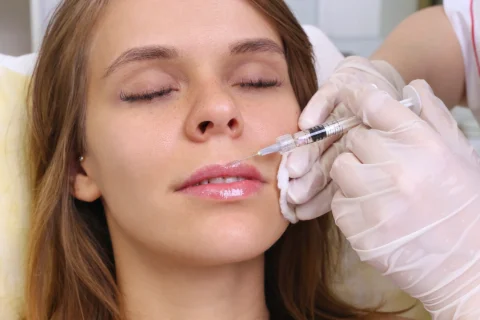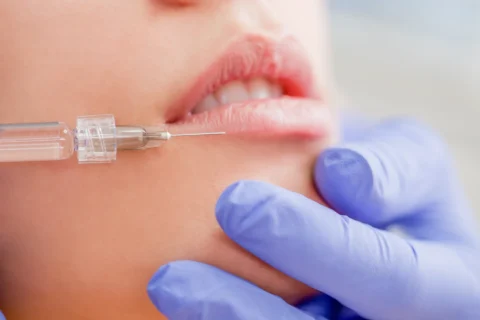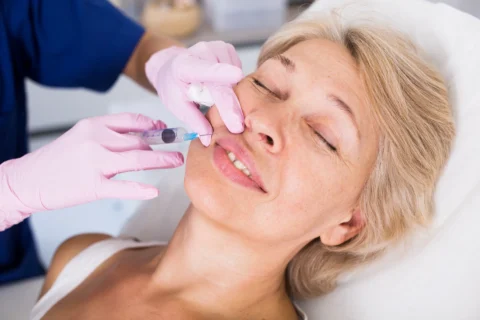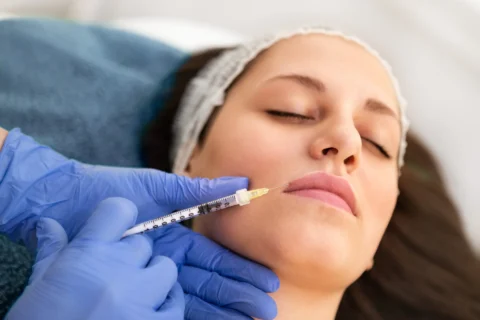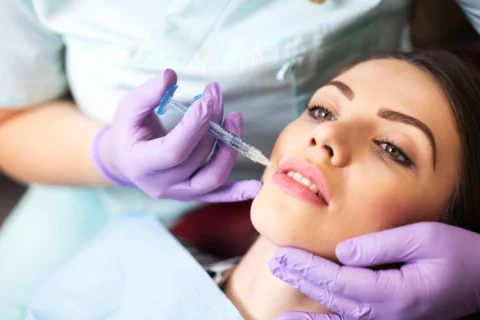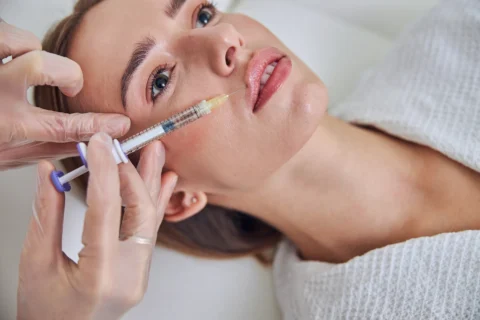A lip filler injection can help any patient get non-invasive lip augmentation, but it isn’t free from risks. One particular complication that’s making the rounds is what happens if the filler material migrates to another location – otherwise known as lip filler migration.
But is lip filler migration something that a patient should be worried about with their lip injection? It’s definitely a possibility, but nothing to be concerned about as long as you have a skilled injector. And even if something goes wrong with your lip injections, there are many ways to fix it.
What Causes Lip Filler Migration?
Several factors can affect the likelihood that your lip filler migrates:
- The brand of dermal filler you’re using
- Your facial anatomy
- Frequency of your lip injections
However, most cosmetic experts agree that the biggest factor that can affect how likely your filler is to migrate is how skilled your injector is. Ideally, a trained and certified injector will be able to compensate for anything that may affect your procedure. But if your filler provider isn’t skilled, the risk of migration becomes higher.
How Do I Know If My Lip Filler Has Migrated?
The good news is that figuring out if your filler has migrated can be somewhat easy as long as you pay attention to the injection site. Specific symptoms may vary from patient to patient, but here are some specific results that you should be looking for:
1) Swelling
The most obvious sign that your lip enhancement has gone wrong is if you’re experiencing swelling, especially in areas adjacent to the injection site. Keep in mind that this particular symptom can easily be mistaken for the usual swelling that accompanies dermal filler treatment, so make sure that you run it through your provider first.
A lump in the wrong place (especially if it doesn’t feel like the rest of your skin) is a probable sign that your filler has migrated. Since your lips do have some definition compared to the surrounding skin, simple observation can suffice to check for migrated filler.
2) Duck Lips
This is particularly apparent if you’ve had an upper lip injection. Duck lips happen when the lip border becomes fuller and less defined. If you notice a lump around your lips after your lip filler treatment, it may be a sign of migrated filler.
Be careful not to mistake this for the result of a fuller lip from your injection, since it’s just the filler settling into your lips over time. Duck lips are far more prominent compared to fuller lip results, and do not go down with time or first-aid treatment.
3) Discomfort In The Injection Site
An early sign that your lip filler has migrated will be a strange sensation or some discomfort whenever you move your lips. While this can be confused for the initial swelling after your treatment, it’s more likely to have migrated if the feeling doesn’t go away or increases.
Longer-lasting or semi-permanent fillers can also trigger this symptom. However, a patient still needs to consult with their filler provider if it’s really caused by filler migrating, or if it’s some other complication from their treatment.
How To Prevent Lip Filler Migration
The best way to prevent lip filler migration is to get an experienced injector to administer your treatment. Poor injection technique, the wrong filler brand, or even mistakes with your treatment schedule can all increase your risk of filler migration. An experienced injector helps you avoid those scenarios.
This is especially crucial if your old filler needs to be replaced or requires additional filler material. It’s important to have an expert who understands how fillers work with previous injections and avoid injecting too much filler to cause migration.
Some ways they can help decrease the risk include:
- Using the right type of filler for your desired result
- Avoiding over-application of filler material
- Scheduling your filler treatments on time
- Preventing bad placements of initial filler injections
- Accounting for your existing lip characteristics
- Monitoring you after your treatment and future injections
It’s important to note that lip filler migration is always a possibility when getting lip injections, but it’s also preventable. Above all else, anticipating this complication (and taking the steps to avoid it) is more likely to result in successful outcomes.
With an experienced injector, you’ll be able to enjoy the result of beautiful lips without any complications.
Treatments For Lip Filler Migration
Filler migration in general can vary depending on the patient. Some patients experience it only once, while it can be a consistent problem for others. Again, finding the right injector can be a great way to manage any filler migration.
If your lip filler has migrated, there are two ways to manage it:
1) Let The Filler Dissolve Over Time
Fillers are not meant to last forever. If you find that your lip filler has migrated and you don’t want to have it actively treated, all you need to do is wait.
How long this process will take usually depends on the type of dermal filler and how much of it is present in the injection area. Brands that use compounds closer to your body’s natural components (such as hyaluronic acid) are absorbed by your body faster. Other factors like your lifestyle can also speed up the process.
This process roughly takes the same amount of time your filler would be present if it didn’t migrate – so on average, around 6 to 12 months.
2) Dissolve The Filler With Additional Injections
If you don’t mind the extra treatment, you can get your fillers dissolved with another injection. Hyaluronidase injections work well with dissolving HA dermal filler brands and work well with spot treatments.
Keep in mind that both active and passive dissolving of filler may not always remove all the filler from the injection site. In most cases, this is because it’s not really needed. Filler migration usually occurs in one specific section of the lips, so treatment doesn’t have to be that intense.
Hyaluronidase injection works best with HA fillers, so consult your provider if another active compound was used in your dermal filler treatment.
Prevent Lip Filler Migration By Getting Dermal Filler at Ethos Spa
Lip filler migration is a possible complication of lip filler treatment, but it’s a very rare occurrence. Having an experienced injector do your lip filler procedure will be enough to prevent any complications or a negative result – and can improve your overall outcome.
Injectable fillers are a great way to help you get closer to your beauty goals. At Ethos Spa, we have experience with different types of skin treatments (including lip filler injections) to give you the results that you want without the need for plastic surgery. To learn more about which of our treatments work for you, get in touch with us today.


